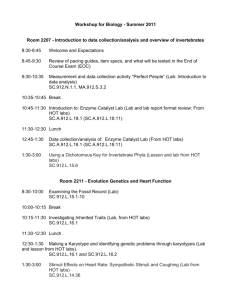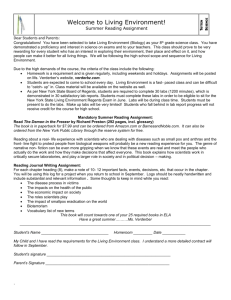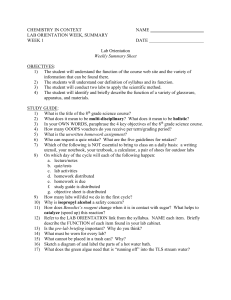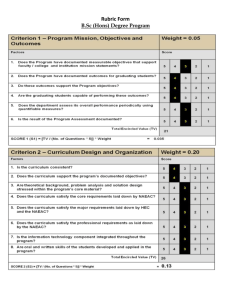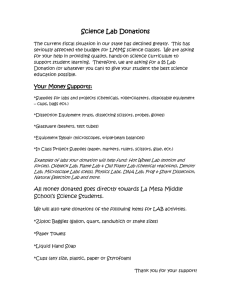PowerPoint XML
advertisement
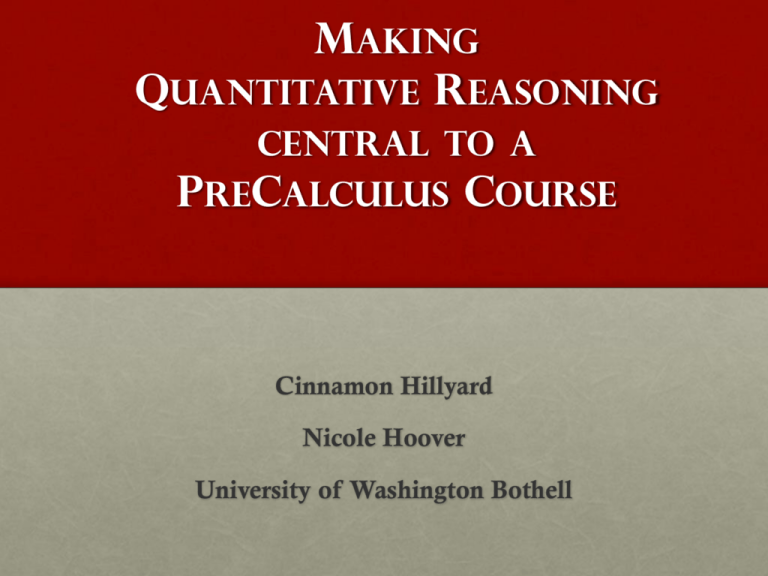
MAKING QUANTITATIVE REASONING CENTRAL TO A PRECALCULUS COURSE Cinnamon Hillyard Nicole Hoover University of Washington Bothell Background • In 2006, UWB started its lower division program. We had the opportunity to build our freshman math courses from scratch. • UWB has a strong foundation/learning goal of QR with it’s QSC started in 2000. • Limited resources and student pool meant we had to have a course that would do double duty: prepare students for calculus AND provide significant QR experience. FUNCTIONS, MODELS, AND QUANTITATIVE REASONING (FMQR) • FMQR is a 5 credit, 10-week course • Students place between 40% and 70% on our QR math placement exam to get into FMQR. • Textbook: “Functions Modeling Change” by Connally, et al. • We cover the general concept of function including average rate of change, domain/range, inverses, intercepts, and composition. We focus on Linear, Exponential, and Sinusoidal mathematical models. • QR is purposefully integrated into all forms of student work including homework, labs, two midterms, comprehensive final, and in-class work. SAMPLE IN-CLASS ACTIVITIES Typical day… (125 min) • Answer questions, • Brief introduction to key topics, • Worksheet with 2-5 contextual problems • End with a review of the “big” ideas learned. The population of King County was approximately 1.5 million in 1990. The 2000 Census reported the population to be 1.7 million. Let the population, P in millions be a function of t, time in years after 1990. a) Find a linear equation to model the population growth. b) Find an exponential equation to model the population growth. c) Use both models to predict the population in King County in 2050. d) Which model is growing faster? Discuss with your group situations in King County which might make the exponential equation or linear equation a better model. ALMOST WEEKLY LABS Introduction to Excel: Census data and marriage rates over time. Linear functions: Blood Alcohol Concentrations Body parts* Exponential functions: Koch snowflakes Short-term loans Radon poisoning* Daylight hours* Romantic cycles* Review labs: Concept maps of mathematical function topics Learning styles and studying mathematics Everything else: extending concepts to a general function. Trigonometric functions: *These labs were adapted from University of Arizona’s pre-calculus course. HOW LABS ELICIT QR • All labs are based on real world issues with real data. • Students hand in word-processed answers with complete sentences including well-designed graphs and tables from Excel. • Students make decisions or hypothesis before calculating anything and then revisit those decisions after doing the math. • Students think about, analyze, and write about what they are computing. • Often, students generate and compare two or more models with different assumptions • Often, students investigate a small research question that follows up on the mathematics. Challenges • Creating meaningful writing and other reflective assignments getting students to recognize what they are doing as QR. (Tried autobiographies, reading and responding Math & Democracy, and online discussions.) • Adaptability of course by instructors hired to teach one section of the course. • Grading and scalability to larger class sizes • Getting students to see it not as a repeat of high school – maybe they haven’t done this all before? STUDENT FEEDBACK: COURSE LED TO QR Movement to “understanding”: • I'm actually understanding all of this, even though I studied it all last year. • I feel like they [logarithms] meant nothing to me when I was just plugging them into the calculator but now I actually feel like I know what I'm putting into the calculator and why it's giving me the answer it's giving me. Excitement about “applying”: • Learning about the third type [periodic] of function was very confusing to me when I first learned about them. But with the real life examples we have been using to learn how they work has helped me a lot to understand. • • I, of course, knew that there was math all throughout the world, but doing these labs has helped point out certain examples. And now every once in awhile, I look at a situation and wonder, what would Cinnamon ask? STUDENT FEEDBACK: QR DEEPENED MATH UNDERSTANDING Learning about learning math: • • In high school I was very used to doing everything on my own, but now, since during every class period we have to work in groups, I’ve been exposed to a completely different learning style in math. At first it was a challenge since I wanted to work at my own pace, but in the end I think it’ll help me because it forced me to understand where everyone else is coming from. Also, being able to explain a concept verbally means that I know the topic well; and if I can't help my classmates, then I know I have some studying to do! I learned that the best way to learn math is by doing it right after the concept is introduced. For example, professor cinnamon introduces a new chapter with new concepts and formulas, after spending time in class she puts us in groups so we can try it out. Multiple representations of mathematics: • I would say the most interesting things that I've learned throughout the quarter was that there are a variety of ways you can demonstrate math concepts or a set of data. For instance, you can use a graph, table, equation or even doing a DANCE =]

